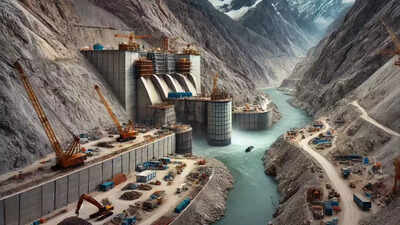Dam gamble on Siang: China moves ahead with its mega project – Will India’s response face local resistance?

Tractors slowly climbed a muddy hillside in Begging village of Arunachal Pradesh’s Siang district, carrying drilling rigs and equipment for a sensitive pre-feasibility study on May 21. The goal was to assess the possibility of building a massive dam across the Siang River, called the Brahmaputra in Assam and Yarlung Zangbo in China.But on the opposite bank, in Parong, anger was already building. The local Adi community, opposed to the dam, had been staging protests. Authorities tried to keep operations quiet, planning to start work in Begging and later ferry equipment across the river.However, within a week, resistance intensified. Protesters marched to Begging, cut off its only link to the outside world, a hanging bridge — and damaged the drilling machines, bringing the survey to a halt, ET reported.Despite growing unrest, law enforcement remained restrained, avoiding confrontation in the sensitive border area. The authorities, cautious of escalation, suspended operations temporarily. NHPC engineers stationed at the proposed drilling location withdrew to Pasighat, the primary town along the Siang, leaving the contested riverbank quiet.This tranquility is temporary. The government remains committed to constructing the Siang Upper Multipurpose Project (SUMP), a Rs 1,50,000 crore initiative. The project features a 267-m-tall dam with 9.2 billion cubic metres (bcm) storage capacity, designed as a strategic reserve against potential upstream water releases by China. The 11,000 MW project offers Arunachal Pradesh 12% free electricity and revenue participation.The timing aligns with Beijing’s recent groundbreaking of the world’s largest dam upstream on the Brahmaputra, initiating strategic water management in the Eastern Himalayas.A critical question emerges: will India’s defensive dam strategy provide effective deterrence or exacerbate environmental vulnerabilities in this sensitive region.The timing is telling. Just days ago, China began work on what is expected to be the world’s largest dam on the upper reaches of the Brahmaputra River. India’s own plans for a massive dam on the Siang — the river’s name in Arunachal Pradesh, appear to be a strategic response.But the move raises a critical question.Can India’s proposed dam act as a credible counter to China’s project, or will it deepen environmental and social challenges in the fragile Eastern Himalayan region?“It (the Chinese dam) is going to cause an existential threat to our tribes and our livelihoods. It is quite serious because China could even use this as a sort of ‘water bomb’,” Arunachal Pradesh Chief Minister Pema Khandu told PTI on July 9, just days before Beijing formally announced the commencement of construction.
China’s first move
China was the first to disturb the fragile peace along the McMahon Line. In 2020, amid rising military tensions with India in Ladakh’s Galwan Valley, Beijing unveiled plans for a massive hydropower project on the Yarlung Zangbo. It was folded into China’s 14th Five-Year Plan, signaling how seriously the country views its strategic importance.That dam, now under construction in Nyingchi near the Great Bend of the river, is expected to outsize even China’s famous Three Gorges Dam. It will feature five cascading power stations, generate 300 million megawatthours (MWh) annually, and cost roughly $168 billion. Premier Li Qiang formally launched the project on July 19, calling it the “project of the century.” China has also created a state-owned firm, China Yajiang Group — to manage construction.China’s capital markets have reacted with enthusiasm. Stocks of key engineering firms surged after the announcement, and the CSI Construction & Engineering Index jumped 4% to hit a 7-month high.
India’s strategic response
India’s proposed SUMP project is seen as a direct counter to China’s dam. The aim: to establish a strategic foothold on the Siang river before it becomes heavily regulated upstream. However, while China’s project is already underway, India’s remains stuck at the pre-feasibility stage.The project has run into stiff resistance from local communities in Arunachal Pradesh. On May 21, when two rigs were quietly moved into the village of Begging to start pre-feasibility drilling, protests broke out on the opposite bank in Parong. Within a week, angry villagers destroyed the rigs and cut off access by damaging a fragile hanging bridge — the only connection to the outside world.
Ecological and cultural fears
Many are also worried about the environmental impact of two mega dams facing off across the McMahon Line. The Eastern Himalayas are a seismically active and ecologically fragile zone. Experts warn that the scale of these projects could disrupt the delicate balance of the region’s rivers and biodiversity.A bigger concern is the potential for water diversion. According to internal government documents, 84% of the Siang’s winter flow in Arunachal Pradesh originates in China. If Beijing decides to divert or block this flow, the Brahmaputra could shrink drastically in the dry season, especially in Upper Assam, before tributaries replenish it downstream, ET reported.
Assam’s position
Assam chief minister Himanta Biswa Sarma has tried to downplay the risks, arguing that 70% of the Brahmaputra’s flow comes from Indian territory and Bhutan, not China. However, experts argue that this may be true on an annual average — but not during the critical winter months, when Chinese-origin water dominates the flow.
Could the Brahmaputra shrink?
Though the Brahmaputra is often seen as a mighty and resilient river, the data reveals a more complex picture, especially during the dry winter months. As per internal documents related to India’s proposed Siang Upper Middle Stage Project (SUMP), 84% of the Brahmaputra’s water in Arunachal Pradesh between November and April originates in China.This raises serious concerns. If China diverts or controls the flow upstream through its new mega dam project on the Yarlung Zangbo, the river’s volume downstream, especially in Upper Assam—could drop dramatically. In its early stretches, before tributaries join in, the Brahmaputra may shrink to a trickle, threatening the region’s ecological balance and biodiversity.The looming presence of two massive dams—one on each side of the McMahon Line—adds urgency to the issue. Experts and locals alike are asking: What will happen to the river and the people who depend on it if both projects go ahead?
Voices from the ground: Protests and fears
In January, during a visit to the proposed dam sites in Arunachal Pradesh—Parong, Dite Dime, and Ugeng—a sense of fear and resistance was clearly visible. Villagers in Parong, which has around 125 families, voiced strong opposition.“We are not just opposing the dam, we are against any feasibility studies being conducted here,” Tato Pabin, a local resident of Parong told ET. “Our orange farms, which thrive in the low-lying areas along the river, will be completely wiped out,” he added.Parong has emerged as the frontrunner site for the dam. The other two locations, Dite Dime and Ugeng, appear to have been dropped from active consideration, according to an official familiar with the project.
Widespread impact on villages
While a full assessment is still pending, initial estimates suggest that nearly 59 villages could be affected by the dam. Of these, at least 15 villages may require complete relocation.So far, only three villages—Pangkang, Riga, and Riew—have given their approval for the project. The rest remain either opposed or undecided, reflecting widespread apprehension in the region.Beyond the human and environmental cost, the proposed dam poses risks to vital infrastructure. A key stretch of road leading to the Tuting Advanced Landing Ground, a strategically important military airstrip near the China border, could be submerged if the project proceeds.This would force authorities to construct an alternative route at a higher elevation—a major logistical and financial undertaking—to maintain military and civilian access in this sensitive frontier zone.As both countries push forward with dam projects, the geopolitical and ecological stakes are higher than ever. Whether India’s dam becomes a deterrent or a new source of conflict — or environmental damage — remains to be seen.




